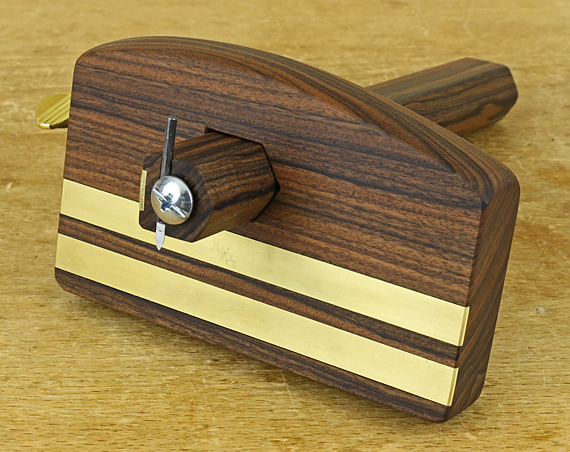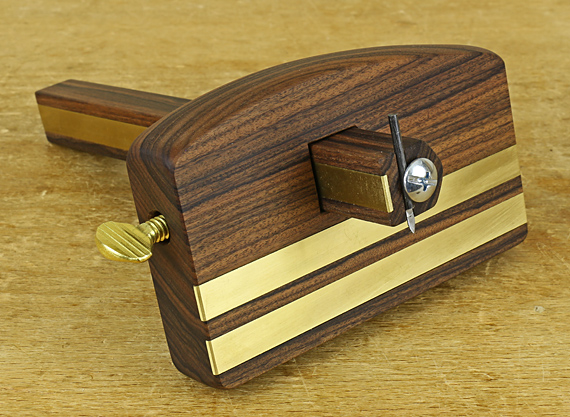
I built this gauge to incorporate specific features that I like and could not find in combination in commercially available models.
This is a hefty tool with a Honduras rosewood (old stock) fence 4 1/2″ x 2 3/4″ x 7/8″. The contoured top edge is similar to my Japanese cutting gauge that has always felt comfortable in my hand. The lower part of the fence gives plenty of area to register on even thick stock, and is protected from wear by two 3/8″ x 1/16″ inlaid brass strips.
In use, my thumb is on top of the fence, with the muscle at the base of the thumb on the lower part of the contour, while the other fingers are below the stem where they can exert pressure on the fence where it meets the workpiece. I like they way the tool handles.
The stem is about 11/16″ thick and 7″ long. It is shaped to go through a matching mortise in the fence that has three sides of a rectangle and a point on the fourth side – like a house. This wedge action makes the stem lock very securely with only modest pressure from the locking screw. Note that the peak on the length of the stem is cut back a bit to prevent it from bottoming out in the mortise.
A feature that I strongly prefer in any gauge (with the exception of a mortise gauge) is the scribing point at the very end of the stem where I can see what it is doing. Here I used a simple half-point scriber from an old gauge. It is secured in a groove with a pan-head screw threaded into the wood.

The other end of the stem is set up with a groove and a tiny bolt that threads into an embedded nut. It holds the excellent Hamilton fingernail shaped knife, which works nicely as a cutting gauge. It also works well along the grain but there I more often like the heavier mark of the half-point scriber. This is two gauges in one.
The locking screw is a 1/4-20 brass thumbscrew that travels through a bronze bushing and threads through an embedded cylindrical nut that is placed about 3/4 of the way along the route of the screw. I like the thumbscrew at the front of the gauge where it is fully out of the way when marking. The locking screw meets a 5/16″ x 1/16″ brass wear strip embedded into the stem. There is no loose metal button pad to get lost.
On the back of the fence, I sealed the hole for the cylindrical nut with a wooden plug. The locking system works very well but in retrospect I think it would have been easier to make or find a brass cylindrical nut, and simply leave one or both ends of it showing.
Overall, I’m pleased with the function, accuracy, and appearance of the result. As usual with any tool making, I suppose I could make another one in a third of the time and with no regrets, but I only need one.
